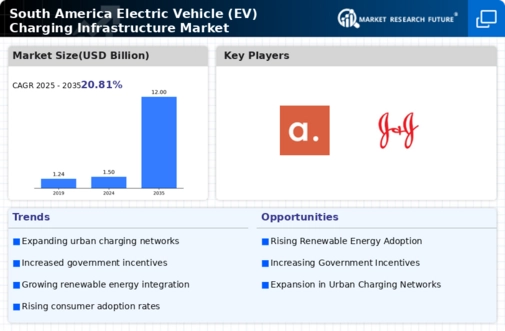Growing EV Adoption Rates
The increasing adoption of electric vehicles across South America is a pivotal driver for the Global South America Electric Vehicle (EV) Charging Infrastructure Market Industry. With rising environmental awareness and the need for sustainable transportation solutions, consumers are increasingly opting for EVs. Countries like Chile and Colombia are witnessing a surge in EV sales, which necessitates the expansion of charging infrastructure to support this growth. Projections indicate that by 2035, the market could expand to 12 USD Billion, driven by the growing demand for EVs and the corresponding need for accessible charging solutions.
Market Growth Projections
The Global South America Electric Vehicle (EV) Charging Infrastructure Market Industry is poised for substantial growth, with projections indicating a market size of 1.5 USD Billion in 2024 and an anticipated increase to 12 USD Billion by 2035. This remarkable growth trajectory suggests a compound annual growth rate (CAGR) of 20.81% from 2025 to 2035, reflecting the increasing investment in charging infrastructure and the rising adoption of electric vehicles across the region. The market's expansion is likely to be driven by a combination of government initiatives, technological advancements, and heightened consumer awareness.
Investment from Private Sector
The influx of private sector investment into the Global South America Electric Vehicle (EV) Charging Infrastructure Market Industry is a crucial factor driving its expansion. Major automotive manufacturers and technology companies are increasingly investing in charging infrastructure to support their electric vehicle offerings. For instance, partnerships between automakers and charging network providers are becoming more common, facilitating the establishment of extensive charging networks. This trend not only enhances the availability of charging stations but also fosters competition, leading to improved services and infrastructure quality. Such investments are anticipated to propel the market towards its projected growth trajectory.
Government Incentives and Policies
The Global South America Electric Vehicle (EV) Charging Infrastructure Market Industry is significantly influenced by government incentives and policies aimed at promoting electric vehicle adoption. Various South American countries have implemented tax breaks, subsidies, and grants to encourage the installation of EV charging stations. For instance, Brazil's federal government has introduced initiatives to support the expansion of charging infrastructure, which is expected to contribute to the market's growth. As a result, the market is projected to reach 1.5 USD Billion in 2024, reflecting the effectiveness of these policies in stimulating investment and development in the EV sector.
Public Awareness and Environmental Concerns
Public awareness regarding environmental issues and the benefits of electric vehicles is a significant driver for the Global South America Electric Vehicle (EV) Charging Infrastructure Market Industry. As consumers become more informed about the impact of fossil fuels on climate change, there is a growing preference for sustainable transportation options. Campaigns promoting the advantages of EVs, coupled with the visible effects of pollution in urban areas, are encouraging more individuals to consider electric vehicles. This shift in consumer behavior is likely to lead to increased demand for charging infrastructure, further supporting the market's growth.
Technological Advancements in Charging Solutions
Technological advancements in EV charging solutions are reshaping the Global South America Electric Vehicle (EV) Charging Infrastructure Market Industry. Innovations such as fast-charging stations and smart charging technologies enhance the efficiency and convenience of charging processes. For example, the introduction of ultra-fast charging stations allows EV owners to recharge their vehicles in a fraction of the time compared to traditional chargers. This technological evolution is likely to attract more consumers to electric vehicles, thereby driving market growth. As the industry evolves, the market is expected to experience a compound annual growth rate (CAGR) of 20.81% from 2025 to 2035.













Leave a Comment